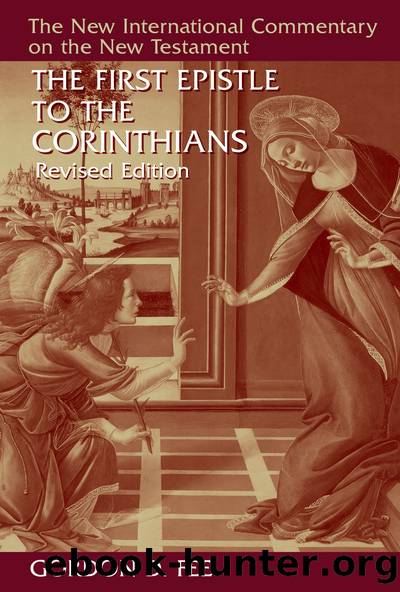The First Epistle to the Corinthians, Revised Edition by Gordon D. Fee

Author:Gordon D. Fee
Language: eng
Format: epub
Publisher: Wm. B. Eerdmans Publishing Co.
Published: 2014-01-15T00:00:00+00:00
ADDENDUM
During the decades following the first edition of this commentary, considerable debate (unrest?) arose in some portions of the evangelical community regarding male/female (usually in the form of âhusband/wifeâ) relationships in the home. Much of it had to do with the meaning of Paulâs use of kephalÄ (âheadâ) in this passage. Since it is not the goal of the present commentary to enter into this debate, but simply to expound the text as best one can on the basis of the available information, I here (as elsewhere; see the introduction to chaps. 8â10) simply append the bibliography that has appeared in the scholarly journals, and again have done so in their chronological order of appearance (in this case including those that also predated the first edition of the commentary):
W. O. Walker, â1 Corinthians 11:2â16 and Paulâs View regarding Women in 1 Cor. 11:2â16,â JBL 94 (1975), 94â110; J. Murphy-OâConnor, âThe Non-Pauline Character of 1 Corinthians 11:2â16?â JBL 95 (1976), 615â21; L. Cope, â1 Cor. 11:2â16: One Step Further,â JBL 97 (1978), 435â36; G. W. Trompf, âOn Attitudes toward Women in Paul and Paulinist Literature: 1 Corinthians 11:3â16 and Its Context,â CBQ 42 (1980), 196â215; P. W. Fiddes, â âWomanâs Head Is Manâ: A Doctrinal Reflection upon a Pauline Text,â Baptist Quarterly (London), 31 (1986), 370â83; D. K. Lowery, âThe Head Covering and the Lordâs Supper in 1 Corinthians 11:2â34,â BibSac 143 (1986), 155â63; A. Padgett, â âAuthority over Her Headâ: Toward a Feminist Reading of St. Paul,â Daughters of Sarah 12 (1986), 5â9; T. P. Shoemaker, âUnveiling of Equality: 1 Corinthians 11:2â16,â BTB 17 (1987), 60â63; H. W. House, âA Biblical View of Women in the Ministry (Part 2 of 5): Should a Woman Prophesy or Preach before Men?â BibSac 145 (1988), 141â61; J. Murphy-OâConnor, â1 Corinthians 11:2â16 Once Again,â CBQ 50 (1988), 265â74; R. Oster, âWhen Men Wore Veils to Worship: The Historical Context of 1 Corinthians 11.4,â NTS 34 (1988), 481â505; H. van de Sandt, â1 Kor. 11, 2â16 als een retorische eenheid [1 Cor. 11, 2â16 as a rhetorical unit],â Bijdragen 49 (1988), 410â25; C. L. Thompson, âHairstyles, Head-Coverings, and St. Paul: Portraits from Roman Corinth,â BA 51 (1988), 99â115; D. Ellul, â âSois belle et tais-toi!â Est-ce vraiment ce que Paul a dit? A propos de I Cor. 11, 2â16,â Foi et Vie 88 (1989), 49â58; J. A. Fitzmyer, âAnother Look at ÎÎΦÎÎÎ in 1 Corinthians 11.3,â NTS 35 (1989), 503â11; W. O. Walker, âThe Vocabulary of 1 Corinthians 11.3â16: Pauline or Non-Pauline?â JSNT 35 (1989), 75â88; D. W. J. Gill, âThe Importance of Roman Portraiture for Head-Covering in 1 Corinthians 11.2â16,â TynB 41 (1990), 245â60; G. P. Corrington, âThe âHeadless Womanâ: Paul and the Language of the Body in 1 Cor 11.2â16, PRS 18 (1991), 223â31; K. T. Wilson, âShould Women Wear Headcoverings?â BibSac 148 (1991), 442â62; J. A. Fitzmyer, âKephalÄ in I Corinthians 11.3,â Int 47 (1993), 52â59; L. A. Jervis, â âBut I Want You to Know â¦â: Paulâs Midrashic Intertextual Response to the Corinthian Worshipers (1 Cor 11.
Download
This site does not store any files on its server. We only index and link to content provided by other sites. Please contact the content providers to delete copyright contents if any and email us, we'll remove relevant links or contents immediately.
The Five People You Meet in Heaven by Mitch Albom(3456)
Real Sex by Lauren F. Winner(2949)
Name Book, The: Over 10,000 Names--Their Meanings, Origins, and Spiritual Significance by Astoria Dorothy(2925)
The Secret Power of Speaking God's Word by Joyce Meyer(2919)
The Holy Spirit by Billy Graham(2877)
0041152001443424520 .pdf by Unknown(2768)
ESV Study Bible by Crossway(2725)
How The Mind Works by Steven Pinker(2712)
Ancient Worlds by Michael Scott(2607)
The ESV Study Bible by Crossway Bibles(2494)
Churchill by Paul Johnson(2493)
The Meaning of the Library by unknow(2485)
The Gnostic Gospels by Pagels Elaine(2459)
MOSES THE EGYPTIAN by Jan Assmann(2360)
Jesus by Paul Johnson(2294)
City of Stairs by Robert Jackson Bennett(2293)
The Complete Dead Sea Scrolls in English (7th Edition) (Penguin Classics) by Geza Vermes(2222)
Ancient Near Eastern Thought and the Old Testament by John H. Walton(2183)
The Nativity by Geza Vermes(2165)
